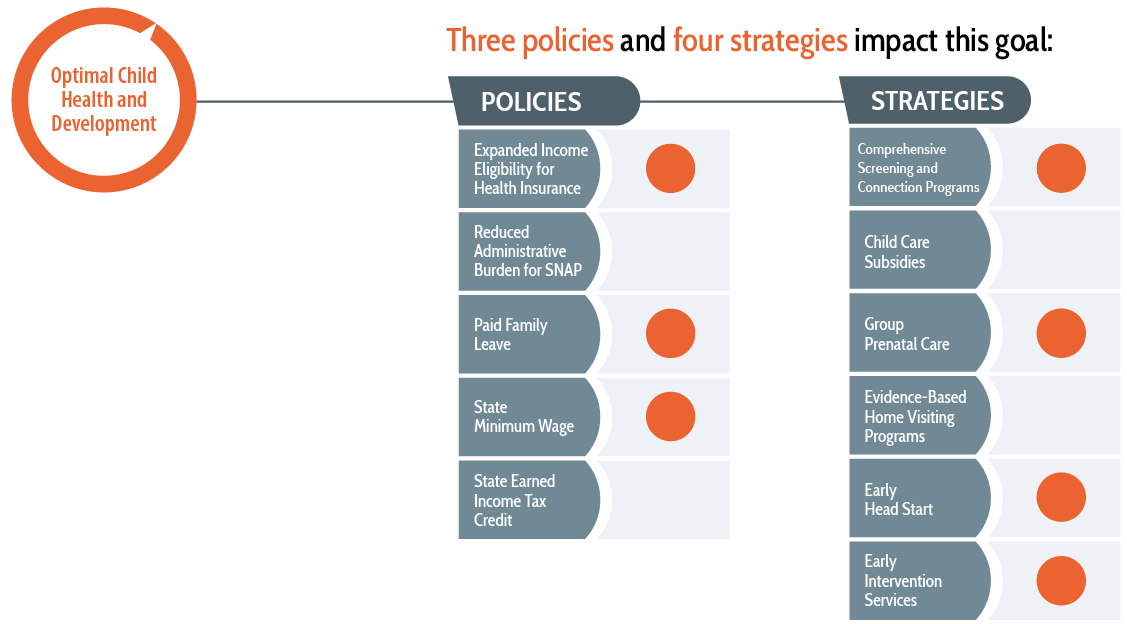
Effective policies and strategies to impact this goal include:
Children’s emotional, physical, and cognitive development is on track, and delays are identified and addressed early.

WHY IS OPTIMAL CHILD HEALTH AND DEVELOPMENT AN IMPORTANT PRENATAL-TO-3 GOAL?
A child’s developing brain is most flexible during the earliest months and years of life. This flexibility provides a window of opportunity for establishing a lifelong trajectory for health and wellbeing. Adverse childhood experiences during this period increase the likelihood of physical and mental health difficulties in adulthood, placing children on a trajectory toward physical health problems, such as cardiovascular disease, diabetes, and respiratory and immunological disorders, as well as challenges with learning and mental health.1,2 Despite the importance of this age period, children are more likely to experience abuse and neglect during their first three years of life than at any other age.3
Safe environments and good nutrition can support lifelong health, as can stable, responsive relationships with adults. Also, interventions that identify and treat early indications of disability or developmental delay during a child’s early years can improve a child’s trajectory, increasing the likelihood of positive health outcomes long term. Such interventions are important because 1 in 6 children in the US has a disability.4 Social predictors of health, such as poverty, increase a child’s risk of disability, as do factors such as low birthweight.5
Breastfeeding can boost children’s immune systems and improve long-term health outcomes, but challenges such as unsupportive workplace policies and hospital practices can limit mothers’ opportunities for breastfeeding, and data show that 60% of mothers do not breastfeed for as long as they intend to.6 These difficulties contribute to racial disparities—Black infants are less likely than Hispanic and White infants to ever have been breastfed.7
The policies and strategies reviewed here have proven effective at directly improving children’s health and wellbeing, and they can help states ensure that children’s emotional, physical, and cognitive development is on track and that delays are identified and addressed early.
HOW ARE STATES CURRENTLY MEETING THIS PRENATAL-TO-3 GOAL?
Three outcomes illustrate factors that predict and reflect children’s healthy development: (1) breastfeeding, (2) immunizations, and (3) child maltreatment rates. These outcomes vary considerably across states, and most vary by race and ethnicity as well.
All three outcome measures were calculated intentionally in the negative direction to demonstrate where states have room for improvement and to help states prioritize the prenatal-to-3 policy goals. The median state indicates that half of states have outcomes that measure better than that state, whereas half of states have outcomes that are worse. Importantly, the “leading” state on a given outcome does not necessarily indicate a target for all other states to strive toward; even in the states with the best outcomes, many children and families are struggling.
OUTCOME MEASURE: NEVER BREASTFED
% children whose mother reports never breastfeeding
Median state value: 15.0%
Breastfeeding is associated with better health outcomes for mothers and children. Overall, nearly 1 out of 6 babies is never breastfed, but the number is nearly double that in the five lagging states and half that in the five leading states. Black infants are approximately 10 percentage points more likely not to be breastfed than White or Hispanic infants.

Source: 2020 National Immunization Survey-Child (NIS-Child).
OUTCOME MEASURE: NOT FULLY IMMUNIZED
% children under age 3 not up to date on immunizations
Median state value: 26.7%
Immunizations protect against a variety of diseases that can lead to serious health consequences. In the US, more than one quarter of infants and toddlers are not up to date on all of their immunizations. Babies in the five lagging states are nearly twice as likely not to be fully immunized as babies in the five leading states. Rates of immunization do not vary substantially by race and ethnicity as compared to other outcomes in this report.

Source: 2020 National Immunization Survey-Child (NIS-Child).
OUTCOME MEASURE: CHILD MALTREATMENT
Maltreatment rate per 1,000 children under age 3
Median state value: 15.9
The trauma from maltreatment has immediate and lifelong neurobiological consequences on children’s development. In the US, approximately 16 per 1,000 infants and toddlers will experience maltreatment, but rates vary widely across states. Infants and toddlers in the five lagging states are maltreated at rates approximately 7 to 18 times higher than infants and toddlers in the five leading states. Black infants and toddlers are almost twice as likely as White or Hispanic infants and toddlers to be victims of maltreatment.

Source: National Child Abuse and Neglect Data System (NCANDS) Child Files, FFY 2020 and Annual Estimates of the Resident Population by Sex, Age, Race, and Hispanic Origin for the United States, Vintage 2020.
For additional information regarding calculation details, data quality, and source data please refer to Methods and Sources.
For more information on outcomes by goal, including by race and ethnicity and state, see the 2022 Prenatal-to-3 State Policy Roadmap section on outcomes across the US.
WHAT ARE THE MOST EFFECTIVE POLICIES AND STRATEGIES TO IMPACT OPTIMAL CHILD HEALTH AND DEVELOPMENT?
Based on comprehensive reviews of the most rigorous evidence available, the Prenatal-to-3 Policy Impact Center identified 11 effective solutions that foster the nurturing environments infants and toddlers need. For each of the five policies, the evidence points to a specific policy lever that states can implement to impact outcomes. For the six strategies, the evidence clearly links the strategy to PN-3 outcomes, but the current evidence base does not provide clear guidance on how states should implement each strategy to positively impact outcomes. Five policies and strategies have demonstrated effectiveness at improving optimal child health and development.

For more information on the impact of state-level policies and strategies in the prenatal-to-3 period, search the Prenatal-to-3 Policy Clearinghouse for an ongoing inventory of rigorous evidence reviews. To learn more about the impact of effective policies and strategies on the eight prenatal-to-3 policy goals, see the Prenatal-to-3 State Policy Roadmap.
SOURCES
- Shonkoff, J., & Garner, A. S., Siegel, B. S., Dobbins, M. I., Earls, M. F., McGuinn, L., Pascoe, J., Wood, D. L. , & Committee on Psychosocial Aspects of Child and Family Health, Committee on Early Childhood, Adoption, and Dependent Care, & Section on Developmental and Behavioral Pediatrics. (2012). The lifelong effects of early childhood adversity and toxic stress. Pediatrics, 129(1), e232-246. https://doi.org/10.1542/peds.2011-2663
- National Scientific Council on the Developing Child (2020). Connecting the brain to the rest of the body: Early childhood development and lifelong health are deeply intertwined, Working Paper No. 15. www.developingchild.harvard.edu
- Child Trends. (n.d.). Child maltreatment. https://www.childtrends.org/indicators/child-maltreatment
- Jenco, M. (2019). Study: 1 in 6 children has developmental disability. AAP News. https://www.aappublications.org/news/2019/09/26/disabilities092619
- Jenco, M. (2019). Study: 1 in 6 children has developmental disability. AAP News. https://www.aappublications.org/news/2019/09/26/disabilities092619
- Centers for Disease Control and Prevention. (n.d.). Facts: Nationwide breastfeeding goals. https://www.cdc.gov/breastfeeding/data/facts.html
- Centers for Disease Control and Prevention. (n.d.). Facts: Nationwide breastfeeding goals. https://www.cdc.gov/breastfeeding/data/facts.html
